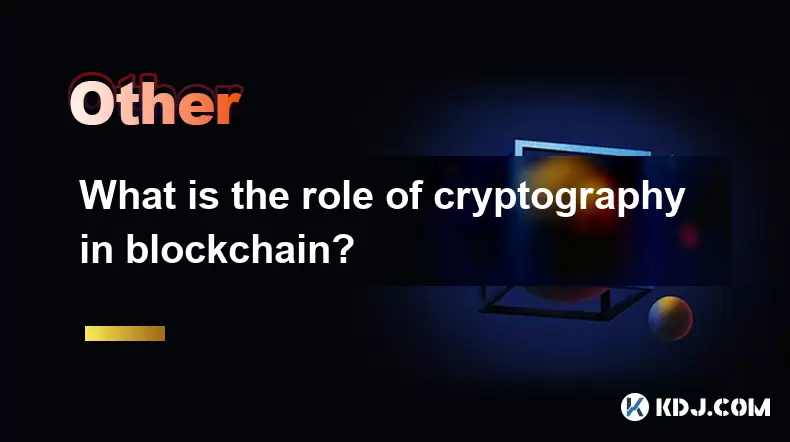-
 Bitcoin
Bitcoin $113900
0.47% -
 Ethereum
Ethereum $3491
-0.42% -
 XRP
XRP $2.876
-1.87% -
 Tether USDt
Tether USDt $1.000
0.03% -
 BNB
BNB $750.4
-0.49% -
 Solana
Solana $161.3
-1.76% -
 USDC
USDC $0.9999
0.01% -
 TRON
TRON $0.3242
-0.91% -
 Dogecoin
Dogecoin $0.1985
-0.19% -
 Cardano
Cardano $0.7241
1.49% -
 Hyperliquid
Hyperliquid $38.05
0.56% -
 Stellar
Stellar $0.3896
2.92% -
 Sui
Sui $3.442
0.61% -
 Chainlink
Chainlink $16.18
0.92% -
 Bitcoin Cash
Bitcoin Cash $541.0
0.51% -
 Hedera
Hedera $0.2427
2.67% -
 Ethena USDe
Ethena USDe $1.001
0.03% -
 Avalanche
Avalanche $21.39
-0.68% -
 Toncoin
Toncoin $3.669
2.25% -
 Litecoin
Litecoin $109.5
0.95% -
 UNUS SED LEO
UNUS SED LEO $8.966
0.11% -
 Shiba Inu
Shiba Inu $0.00001218
0.77% -
 Polkadot
Polkadot $3.598
1.23% -
 Uniswap
Uniswap $9.164
1.14% -
 Monero
Monero $297.7
1.21% -
 Dai
Dai $1.000
0.00% -
 Bitget Token
Bitget Token $4.328
0.84% -
 Pepe
Pepe $0.00001047
1.05% -
 Cronos
Cronos $0.1329
0.70% -
 Aave
Aave $257.6
1.03%
What is a PLONK proof system on a blockchain?
PLONK, a versatile zero-knowledge proof system, uses polynomial commitments and permutations for efficient, non-interactive proofs in blockchain applications.
Apr 14, 2025 at 12:00 am

Introduction to PLONK Proof System
The PLONK proof system, short for Permutations over Lagrange-bases for Oecumenical Noninteractive arguments of Knowledge, is a type of zero-knowledge proof protocol used in blockchain technology. Zero-knowledge proofs allow one party to prove to another that a given statement is true, without revealing any information beyond the validity of the statement itself. PLONK is particularly notable for its versatility and efficiency, making it a popular choice for various blockchain applications.
How PLONK Works
At its core, PLONK uses polynomial commitments to enable efficient and scalable zero-knowledge proofs. Unlike other systems, PLONK does not require custom circuits for each application, which makes it highly adaptable. The system relies on polynomials to represent statements and commitments, allowing for non-interactive proofs that can be verified quickly.
- Polynomial Commitments: In PLONK, data is represented as polynomials. A commitment to a polynomial is a way to prove that a polynomial of a certain degree exists, without revealing the polynomial itself.
- Permutations: PLONK uses permutations to enforce the correct relationships between different parts of the polynomial, ensuring the integrity of the proof.
- Lagrange Bases: These are used to represent the polynomials in a way that is efficient for both proving and verifying.
Applications of PLONK in Blockchain
PLONK has been integrated into various blockchain platforms due to its flexibility and efficiency. Some of the notable applications include:
- Privacy Transactions: PLONK can be used to enhance privacy in blockchain transactions by allowing users to prove the validity of transactions without revealing sensitive information.
- Scalability Solutions: By enabling faster and more efficient proofs, PLONK helps in scaling blockchain networks, making them more capable of handling high transaction volumes.
- Smart Contract Verification: PLONK can be used to verify the execution of smart contracts in a zero-knowledge manner, ensuring that the contract's logic is correctly implemented without exposing the underlying data.
Advantages of PLONK Over Other Proof Systems
PLONK offers several advantages that make it stand out among other zero-knowledge proof systems:
- Universal and Updateable SRS: PLONK uses a Structured Reference String (SRS) that can be used for multiple proofs and can be updated without compromising the security of existing proofs.
- Efficient Verification: The verification process in PLONK is highly efficient, which is crucial for blockchain applications where speed and scalability are important.
- Flexibility: PLONK can be used with a wide range of applications without requiring custom circuits, which reduces development time and costs.
Implementing PLONK on a Blockchain
To implement PLONK on a blockchain, several steps need to be followed:
Setup the SRS: The first step involves setting up the Structured Reference String. This is a public parameter that is used to generate and verify proofs. It must be generated securely to ensure the system's integrity.
- Generate the SRS: Use a trusted setup ceremony to generate the SRS. This involves multiple parties contributing randomness to ensure that no single party can compromise the system.
- Publish the SRS: Once generated, the SRS is published on the blockchain for use in proofs.
Develop the Prover and Verifier: The prover and verifier components need to be developed to generate and verify PLONK proofs.
- Prover: The prover takes the statement to be proven and generates a proof using the SRS. This involves constructing polynomials and computing the necessary commitments.
- Verifier: The verifier uses the SRS and the proof to check the validity of the statement. This involves checking the polynomial commitments and ensuring that the permutations are correctly applied.
Integrate with the Blockchain: The PLONK system needs to be integrated into the blockchain's protocol.
- Modify the Consensus Mechanism: Adjust the consensus mechanism to include the verification of PLONK proofs as part of the block validation process.
- Implement Privacy Features: If privacy is a goal, implement features that use PLONK to enable private transactions or smart contract executions.
Testing and Deployment: Thoroughly test the PLONK implementation to ensure its correctness and efficiency before deploying it on the mainnet.
- Unit Testing: Test individual components of the PLONK system to ensure they function correctly.
- Integration Testing: Test the entire system to ensure that the prover and verifier work together seamlessly.
- Deployment: Deploy the PLONK system on the blockchain's mainnet after successful testing.
Challenges and Considerations
While PLONK offers many benefits, there are also challenges and considerations that need to be addressed:
- Complexity: The mathematical concepts underlying PLONK, such as polynomial commitments and permutations, can be complex and challenging to implement correctly.
- Security: The security of PLONK depends on the secure generation and management of the SRS. Any compromise in this process can undermine the entire system.
- Performance: While PLONK is designed for efficiency, the actual performance can vary depending on the specific implementation and the underlying blockchain architecture.
Frequently Asked Questions
Q: Can PLONK be used for any type of blockchain?
A: Yes, PLONK is designed to be versatile and can be adapted for use with various blockchain platforms, provided the necessary modifications are made to the blockchain's protocol.
Q: How does PLONK compare to other zero-knowledge proof systems like zk-SNARKs and zk-STARKs?
A: PLONK offers a balance between the efficiency of zk-SNARKs and the transparency of zk-STARKs. Unlike zk-SNARKs, PLONK does not require a trusted setup for each new circuit, and unlike zk-STARKs, PLONK proofs are smaller and faster to verify.
Q: What are the main components of a PLONK proof?
A: The main components of a PLONK proof include polynomial commitments, permutations, and a Structured Reference String (SRS). These elements work together to enable the generation and verification of zero-knowledge proofs.
Q: Is it possible to upgrade the SRS in PLONK without affecting existing proofs?
A: Yes, one of the key features of PLONK is its ability to use an updateable SRS. This means that the SRS can be upgraded without invalidating existing proofs, which is a significant advantage over other systems.
Disclaimer:info@kdj.com
The information provided is not trading advice. kdj.com does not assume any responsibility for any investments made based on the information provided in this article. Cryptocurrencies are highly volatile and it is highly recommended that you invest with caution after thorough research!
If you believe that the content used on this website infringes your copyright, please contact us immediately (info@kdj.com) and we will delete it promptly.
- Altcoins Most Searched: Hedera (HBAR) and the ETF Hype
- 2025-08-03 20:50:16
- Arbitrage Adventures: Creditcoin, Kaspa, and Chasing Crypto Profits
- 2025-08-03 20:30:16
- Claude HIVE & Code Agents: Faster Coding Revolution?
- 2025-08-03 20:50:16
- Trump Media, Bitcoin, and Crypto: A Surprising Alliance in the Making?
- 2025-08-03 21:30:16
- Shiba Inu's Bullish Reversal Hopes Amid Market Uncertainty: A Deep Dive
- 2025-08-03 21:30:16
- Shiba Inu's Struggle, Mutuum Finance's Rise, and Key Support Levels: A Crypto Deep Dive
- 2025-08-03 20:55:16
Related knowledge

What is the difference between on-chain and off-chain transactions?
Aug 02,2025 at 04:22pm
Understanding On-Chain TransactionsOn-chain transactions refer to digital asset transfers that are recorded directly on a blockchain ledger. These tra...

What is a node's role in a blockchain network?
Aug 03,2025 at 03:16pm
Understanding the Function of a Node in a Blockchain NetworkA node is a fundamental component of any blockchain network, acting as a participant that ...

What is the double-spending problem and how does blockchain prevent it?
Aug 02,2025 at 01:07pm
Understanding the Double-Spending ProblemThe double-spending problem is a fundamental challenge in digital currency systems where the same digital tok...

What is the difference between a blockchain and a database?
Aug 01,2025 at 09:36pm
Understanding the Core Structure of a BlockchainA blockchain is a decentralized digital ledger that records data in a series of immutable blocks linke...

How does blockchain handle scalability?
Aug 02,2025 at 02:58pm
Understanding Blockchain Scalability ChallengesBlockchain scalability refers to a network's ability to handle an increasing volume of transactions wit...

What is the role of cryptography in blockchain?
Aug 03,2025 at 03:42pm
Understanding the Foundation of Blockchain SecurityCryptography is the cornerstone of blockchain technology, providing the essential tools to ensure d...

What is the difference between on-chain and off-chain transactions?
Aug 02,2025 at 04:22pm
Understanding On-Chain TransactionsOn-chain transactions refer to digital asset transfers that are recorded directly on a blockchain ledger. These tra...

What is a node's role in a blockchain network?
Aug 03,2025 at 03:16pm
Understanding the Function of a Node in a Blockchain NetworkA node is a fundamental component of any blockchain network, acting as a participant that ...

What is the double-spending problem and how does blockchain prevent it?
Aug 02,2025 at 01:07pm
Understanding the Double-Spending ProblemThe double-spending problem is a fundamental challenge in digital currency systems where the same digital tok...

What is the difference between a blockchain and a database?
Aug 01,2025 at 09:36pm
Understanding the Core Structure of a BlockchainA blockchain is a decentralized digital ledger that records data in a series of immutable blocks linke...

How does blockchain handle scalability?
Aug 02,2025 at 02:58pm
Understanding Blockchain Scalability ChallengesBlockchain scalability refers to a network's ability to handle an increasing volume of transactions wit...

What is the role of cryptography in blockchain?
Aug 03,2025 at 03:42pm
Understanding the Foundation of Blockchain SecurityCryptography is the cornerstone of blockchain technology, providing the essential tools to ensure d...
See all articles

























































































